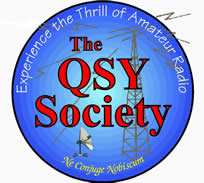
The QSY Society Amateur Radio Club on Facebook
Please join us: www.facebook.com/groups/QSYList
The QSY Society is affiliated with the American Radio Relay League (ARRL) . Membership is FREE and all members are LIFE MEMBERS!
One need only complete a simple application form. Meetings are held once a month at the East Fishkill Community Library. Please click on buttons “About QSY” and “Join QSY” to learn more about us and to apply for membership. We’d love to have you join us!

What Is Ham Radio?
Ham Radio, also known as Amateur radio, is a popular hobby that involves the use of radio equipment to communicate with other Amateur radio operators around the world. Ham radio enthusiasts, or Hams, use a wide range of frequencies to communicate with other hams, including local VHF and UHF frequencies, as well as high-frequency (HF or Short Wave ) bands that can bounce signals off the Earth’s ionosphere to communicate with other hams on the other side of the world.
Ham Radio Operators regularly contribute to the general wellbeing of our community and nation through participation in organizations such as SKYWARN weather reporting, the Amateur Radio Emergency Service and the Radio Amateur Civil Emergency Service.
In times of natural disasters, emergencies, or other crisis situations, Ham radio operators can be called upon to provide critical communications support to emergency responders, government agencies, and other organizations.
Ham Radio Operators can also participate in a Department Of Defense sponsored program called the Military Auxiliary Radio Service by becoming a licensed MARS Operator.
In addition to informative, emergency and conversational communications, Ham radio enthusiasts also enjoy participating in contests and competitions, where Hams try to make as many contacts as possible within a given timeframe. These contests can be held on local, regional, or even international levels, and can involve a wide range of modes and frequencies.
The origins of Ham radio can be traced back to the early 20th century, when wireless technology was in its infancy. Amateur radio operators were some of the earliest pioneers of wireless technology, experimenting with ways to communicate over long distances using radio waves. Today, Ham radio has evolved into a diverse and vibrant community of enthusiasts who use the latest technology to communicate with other Hams around the world.
One of the key aspects of Ham radio is the ability to communicate with other Hams using a variety of communication modes . These modes include voice, where Hams use their voices to communicate with other Hams over the radio; digital modes, where Hams use computers and specialized software to send and receive messages; and Morse code, where Hams use a series of dots and dashes to communicate over the airwaves.
Each communication mode has its own unique advantages and challenges. Some of the most popular modes include:
Voice: This is the most common mode of communication in Ham radio. Hams use a variety of voice modes, including AM, FM, and single-sideband (SSB) to communicate with each other. Voice communication can be used for casual conversations or for more formal exchanges, such as passing messages or participating in a net (a scheduled meeting of Hams on a particular frequency).
Morse code: Morse code is a simple, efficient mode of communication that has been used in Ham radio since its inception. Many Hams still enjoy using Morse code today, either for its simplicity or as a way to communicate when other modes of communication are not possible.
Digital modes: Digital modes use computers and specialized software to send and receive signals. These modes can be very efficient and can often transmit signals that are too weak for voice communication. Some popular digital modes include RTTY, PSK31, and FT8.
Satellite communication: Hams can use satellites orbiting the earth to communicate with each other. This requires specialized equipment and antennas, but it can be a fun and challenging mode of communication.
Slow-scan television (SSTV): SSTV allows Hams to send and receive images over the airwaves. This mode can be used for sending pictures of equipment or antennas, or just for fun.
To become a Ham radio operator, one must pass an exam that tests their knowledge of radio theory, regulations, and operating procedures. These tests are generally given on a regular schedule at one of the many local Ham Radio Clubs. Once licensed, Hams can use a wide range of equipment to communicate with other Hams around the world.
In conclusion, Ham radio is a fascinating and rewarding hobby that offers a wide range of opportunities for communication, competition, and service to the community. Whether you’re interested in voice communication, digital modes, or Morse code, there is something for everyone in the world of Ham radio. So why not give it a try and join the millions of Hams around the world who enjoy this exciting and challenging hobby?